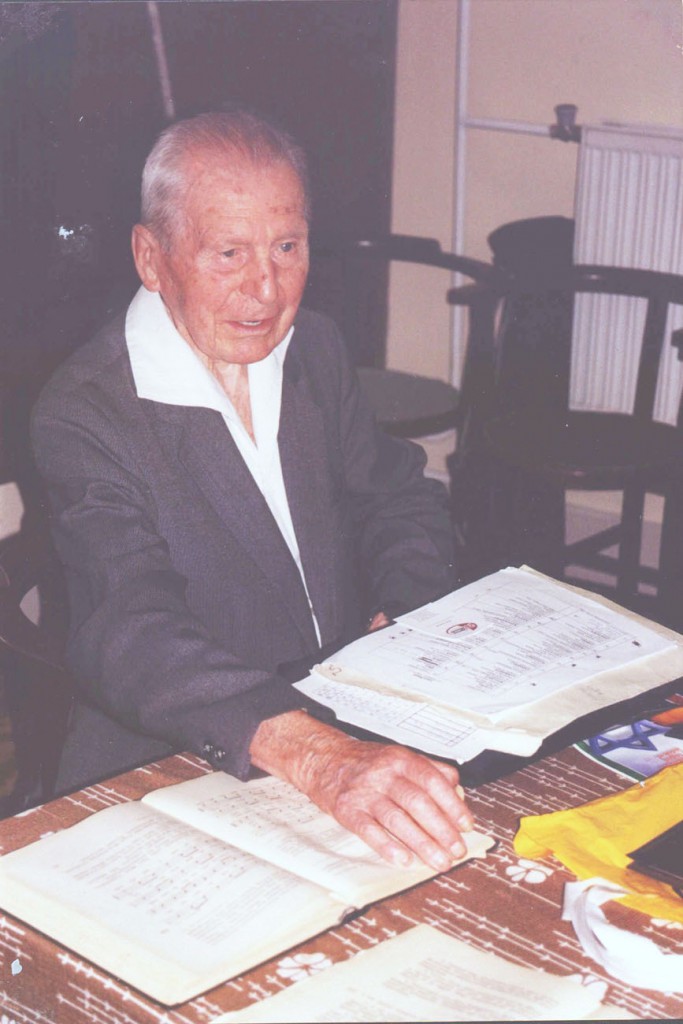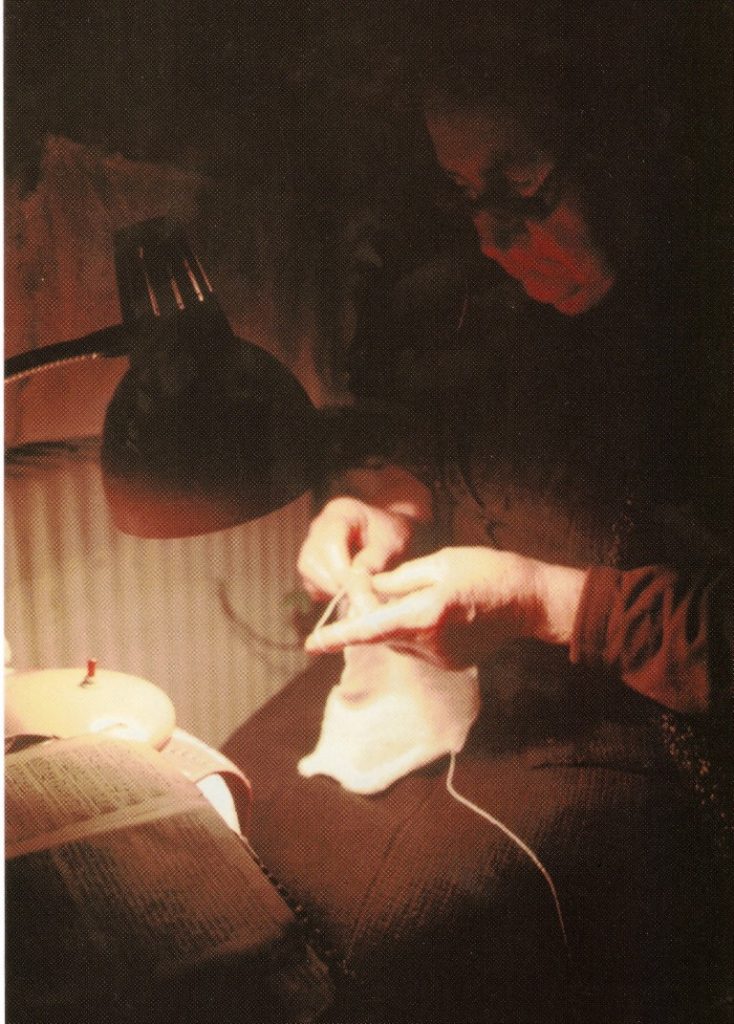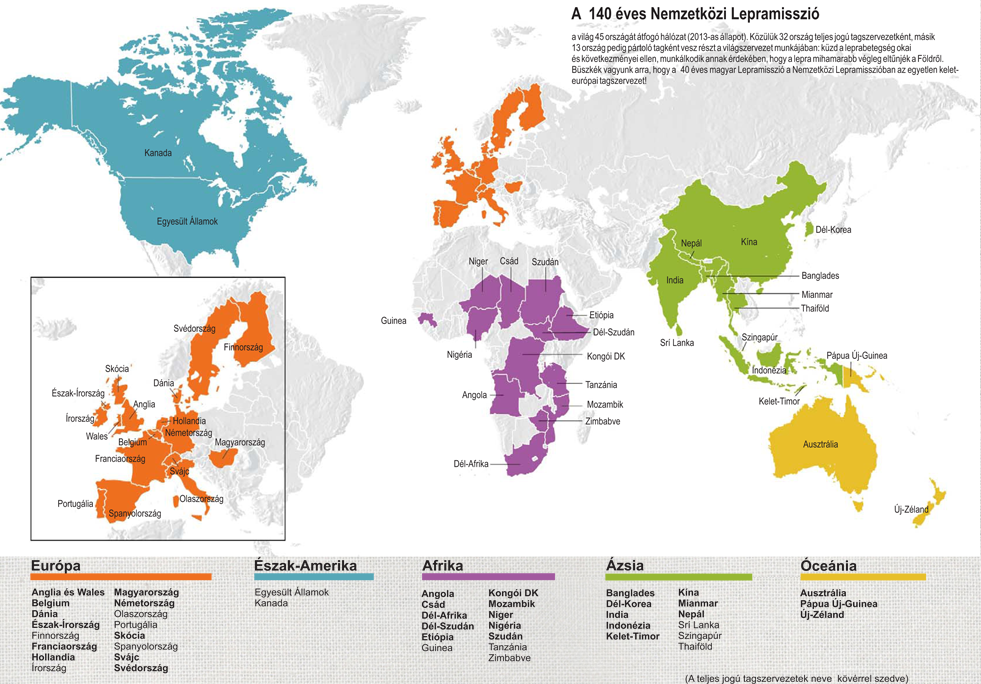Exactly 100 years after Wellesley Bailey's inspiration, the then 72-year-old Reformed pastor Károly Dobos (1902-2004) was called to Hungary to show compassion to lepers in distant continents. During a visit to Hungary by a Belgian friend of his youth, he heard about the misery that the disease continues to cause, despite the fact that it is curable, but help is very difficult to reach. It was also Mr Toureille who encouraged Károly Dobos to hold the 20th World Leprosy Day in Hungary on the last Sunday in January 1974 to commemorate the healing work carried out among the millions of people affected by leprosy.

January 1974 thus became the official "birthday" of the Hungarian Lepramism Society.
Károly Dobos recognised how to mobilise as many people as possible from Hungary in the 1970s, which was living in difficult circumstances, to help philanthropy. He recruited women to make hand-knitted fashlik, which were useful for the large number of leprosy patients, and which were sent to the hospitals of the International Leprosy Federation in small postal parcels on a weekly basis. For three decades, this was the possible and ingenious help from Hungary, through which many thousands of Hungarians became aware of the objectives of the Leprosy Mission and undertook to help directly.
 Hundreds of women across the country knit the wound dressings with sacrificial labour
Hundreds of women across the country knit the wound dressings with sacrificial labour
By 2002, we were able to gain recognition as a member organisation of The Leprosy Mission International, based in England. Since then we have been the only Eastern European organisation in the world's largest leprosy organisation! This is a great pride for us, but also a great obligation.
The following article was written in 1991 by Károly Dobos, then 89 years old, the founder of the Hungarian Lepramissiion of blessed memory. It describes the work of the then 17-year-old organisation from its beginnings. His personal testimony of how, by divine inspiration, he established a missionary field that was previously unknown in a country still under communist leadership is of historical value! Under impossible circumstances he found possible ways to inspire and mobilize Hungarian people, to motivate them to a useful, valuable, personal mission. Károly Dobos is an excellent example of what Mahatma Gandhi, the great benefactor of the lepers, said: 'You yourself should be the change you wish to see in the world.'
We honour the sacrifice, guidance, wisdom and service of our founder Károly Dobos, who continues to inspire us to this day.
"My father-in-law's stepson, the late Bishop Alexander Augustos of Yugoslavia, Paul D'Ans, was expatriated to Switzerland and, as a multilingual man, was recruited in 1970 by the International Lepramism World Headquarters in London to serve the organisation in Europe. The leprosy organisations have since conventionally deleted the word from their dictionaries because of its stigmatising connotations. Instead, the word 'leper' or 'leprosy sufferer' is the word used today.) has toured Western Europe with a colour film. He gave lectures with film screenings and collected donations for the Leprosy Society. Because there was already a cure, more and more countries were asking London for help to cure their lepers. Pál D'Ans also visited several Hungarian Reformed congregations in Yugoslavia to give lectures, and translated a small four-page brochure into Hungarian entitled "20 things to know about leprosy!" This little piece of writing was very new and interesting to me, and I wanted to know more about it. But at that time there was no question of someone from Yugoslavia coming to our country to give a lecture.
Two years later, however, a retired French Reformed pastor arrived in our country, having previously served as a missionary in the Belgian Congo (now Zaire) in Africa. He came to visit his former theological colleague, Dr. Miklós Makay, a Reformed theological teacher with whom he had studied at the Montpellier Reformed Theology. He told him that he had taken over the leprosy traveling ministry in Western Europe from Paul D'Ans, and that he would like to inform the supreme leader of the Reformed Church in Hungary, Bishop Tibor Bartha, of the good news that there is already a cure for leprosy, and that it would be nice if the Hungarian Reformed Church could somehow join in this mission and charity ministry. The meeting with the bishop did not succeed, but Dr. Miklós Makay made a long interview with him about the work of the International Leprosy Mission. Pastor Toureille visited our country again the following year, but he did not manage to meet either the Bishop or the Secretary General of the Ecumenical Council. Miklós Makay told Mr. Toureille that in our present situation they would hardly allow someone from the West to give a lecture in the congregations, and our money is worthless in the West, so we cannot help with it. But he told us that shortly after the discovery of the Dapsone pill in 1946, the United Nations called on governments, churches and social organisations around the world to join forces to stop the spread of leprosy and to support the work of the International Leprosy Society. The last Sunday in January has also been designated by the UN World Health Organisation as "Leprosy Sunday" to commemorate leprosy around the world, and to encourage Christians to pray and donate to this work. It would be nice if we in the Hungarian Reformed congregations could make the cause of lepers known to the faithful on this Sunday, and if we could pray for the healing of lepers in the congregations, and ask God for workers, workers with a Christian spirit, because not everyone is willing to serve among the poor, stinking lepers. For this we need Christian, fearless love. We could write a few articles about leprosy in our church magazine, and God will show us more! - he suggested.
Before the sickly old missionary returned, he asked his friend Dr. Miklós Makay to be the master of the lepers' cause in our country. At least on "World Leprosy Day" in January, place an article about lepers in our church magazine! However, the sickly religion teacher did not do this either, but brought Mr. Toureille to my parish in Pesthidegkút and asked me to do it.
I was very glad to hear that there was now a cure for leprosy, and I dared not refuse the old missionary's request, because I felt that through him God was calling me to serve in this cause. I thought I would keep leprosy Sunday in my own church. Mr Toureille also told me that in 1974 the International Leprosy Mission would be celebrating its centenary, and I would be invited to attend.
I was denied a passport for 28 years, but miraculously in 1975 I was able to travel to the International Lepramism Mission in London, where I was able to see their work around the world, and there I saw English women making 1 kg gift bags from wound dressing stitches knitted by women members of the churches. It was there that God gave me the idea that Hungarian women could knit such things! I have asked for the addresses of two hospitals where we can send these knitted fashlik. I received an address in Burma and one in Zaire, and a series of slides on the work of the International Leprosy Mission in Nepal, as well as brochures.
When I got home, I wrote a petition to the Synod Council, and asked the supreme leadership of our church to join in the missionary charity of Christ's commandment, at least by observing the leprosy Sunday at the end of January, because in our Bible, too, there is the command of Jesus: "Heal the sick, cleanse the lepers!" (Matthew 10:8)
For six years I received no response to the petition, but in 1977, after retiring at the age of 75, I started to give ecumenical-based projection lectures on the Lepramis Mission. To accompany the series I had brought from London, I commissioned a series of slides about a Hungarian Salvation Army girl, Elizabeth Pantea, who served in the leper colony in Indonesia from 1931 to 1938, when there was no cure for leprosy. Pantea Erzsébet's sister was a member of the Reformed congregation in Budapest-Fasor. I knew about her sister in Indonesia from her. I corresponded with her, asked her for pictures and put together a series of lectures.
I recruited for bandages during the lectures, asked for donations for postage.
I also exchanged letters with the Burmese doctor, and he told me after the revolution that their 150-bed hospital (Mawlamyne) was in a difficult situation. There was only one sheet in the whole hospital, he wrote, in the operating theatre. They put palm leaves under the patients, and when they get full of pus and bloody discharge, they burn them and put a new one underneath. God gave me the idea that they were in great need of sheets. I have written to Reformed and Lutheran prayer groups. My Baptist pastor friend, Ferenc Szegedi, who had been forced into forced retirement, promised to mobilize his Baptist pastor friends in this matter, and soon we supplied the Burmese Christian leper hospital with more than 300 sheets! When we also learned from the Burmese doctor that 140 of their leper school children, children of leper beggars, needed some linen to wear to school, we sent them green and white sheets. The green ones for trousers and skirts, the white ones for blouses and shirts, and for Christmas they made Hungarian "uniforms" for all the children, and after Christmas they went to school in them!
Back in 1982, I wanted at least 24 members of the Ecumenical Council to see a film on leprosy produced by the International Leprosy Society in London. Dr. Károly Tóth, then Secretary for Foreign Affairs of the Synod, obtained permission from the Church Office to show the film. However, much to my regret, the film was not shown for several months and I had to send it back unfinished.
However, to our great delight, in the early 1980s we were visited twice by the Italian-born leprosy travelling secretary Silvano Perotti! The first time I saw the first personal account of his leprosy missionary work was at Miklós Czégény's apartment. The second time Mr. Perotti was here, he managed to give a lecture with a projection to the theologians of Budapest and Debrecen, because I thought it was important that the future generation of pastors should know something about the Lepramissios.
In 19878, retiring at the age of 75, I joined the Lepramissi Service as a full-time volunteer.
On the journey I took my missionary friend Gyula Sütő, who was preparing for mission together with 25 others at the time of the awakening in 1948, at the short-lived mission school in Hajdúböszörmény, as my helper and chosen successor in the work. Gyula Sütő worked in the ironworks in Stalin's town, retired from there at the age of 55 and enrolled in the Budapest Theology School. After completing this, the leadership of the Diocese saw a great need for Gyula Sütő's ministry in several congregations in Baranya. So I was left without travelling help.
However, God has given us an ecumenical group of 25 people, volunteer workers, mostly widowed sisters, unmarried girls and a few men, with whom we meet every Monday morning to prepare 25-30 1 kg gift bags. In these we send to 30 leprosy hospitals in 16 countries hand-knitted fabrics, coloured sheets suitable for white and poor lepers, towels, mosquito nets, sometimes white coats for nurses, toys for children with leprosy, and garden seeds for the kitchen gardens of some hospitals.
It is a miracle of God that, thanks to the intervention of the Red Cross, one of the yarn factories in Pécs used 5-6 hundredweight of baby yarns per year for knitting faschlik.
There was a year when the Hungarian Red Cross paid HUF 80 000 for the air transport of 5 hundredweight of wood and sheets we sent to them, but as these larger consignments were either lost in transit or were left in warehouses and a large penalty was paid in foreign currency, we switched to sending 1 kg "gift packs". These are usually received duty free.
We always send a letter to donors thanking them for their donations of money and in-kind donations, and include a news story from the world of leprosy for you to read. These texts are translated from leprosy magazines and correspondence by our dear colleagues.
On Mondays, we start our work with a common devotion, just like in the leprosy hospitals. The Word and testimony are always brought by a different person. Afterwards we have prayer together. For eight years, through the intercession of János Nagy, the presbyter of the Reformed Church in Bp-Baross Square, we have been doing our packing work in the Synod House. But since the spring of 1989, we have been working in the building at 3 Alag u., where the Rescue Mission and the Transylvanian Refugee Action were also located.
In the 1980s, we learned that a Hungarian Reformed doctor, Dr. Erzsébet Fekete, a dermatologist, obstetrician and gynecologist, spent 6 years among lepers in Nigeria and then in Ethiopia with her husband. In fact, in Ethiopia, she organised the leprosy healing work of the whole country. They were sent by the Hungarian government to the two African countries at the request of the UN. This was an honourable sacrifice on the part of our government, because the salary of the medical couple had to be paid in dollars.
It is wonderful that some individuals and congregations from Yugoslavia, the Highlands, Transylvania, the United States, Canada, and even Australia have been joined in the outreach ministry to lepers by Hungarian ecumenical groups. For example, when five young men of Dr. Erzsébet Fekete needed five pairs of good boots and five sleeping bags to transport medicine to remote places that could only be reached on foot, an ecumenical Hungarian women's prayer group in Australia sent them the necessary items at my request!
God has also made it possible for us to send $3,000 a year for the past five years to a leprosy hospital in another African country through the Hungarian Ecumenical Africa Sunday Offering. This way we have sent effective financial aid to Zaire, Tanzania, Angola, Ethiopia, Nigeria, Uganda. Most recently to Mozambique. On this
money was used to buy corn in Tanzania, for example, because of the famine. In Angola, tin sheets were bought to cover the roofs of lepers' huts because the drought had prevented enough grass from growing to cover the roofs of the huts. And in Uganda, where hospital buildings destroyed in internal tribal fighting had to be rebuilt, a much-needed truck was bought to transport materials.
And when they first heard about the leprosy mission in one of the larger Hungarian Reformed congregations in Transcarpathia, they immediately donated 60 or so sheets and a considerable amount of money, which they sent to the recently discovered leprosy colony in Kazakhstan.
Every year, we hold an ecumenical "World Leprosy Day" in Budapest on the last Sunday of January, and we try to reach out to individuals from the International Leprosy Federation on these occasions.
Missionaries who come home on leave from work help to bring the responsibility for leprosy closer. This is how doctors and nurses from Bangladesh, Guinea, Angola, Zaire, Bhutan, Ethiopia, Cameroon, South Africa, New Zealand, Australia, Nepal, Papua New Guinea, Uganda and India have made a lecture tour with us.
We are in constant contact with the leprosy hospitals we support. We only send gift parcels to the countries where they are received duty free. In Africa we have also sent aid to lepers cared for by the Sisters of Mother Teresa.
Where we have the opportunity, we also try to inform children's churches about the situation of children with leprosy, and we try to place leprosy mission boxes in children's churches.
There is still much to do to cure the world's lepers!
After all this, we can only say of the work of the Hungarian Lepramism Mission, "It is of the Lord and wonderful in our eyes!"
May 1991
Dr. Károly Dobos, pastor, leader of the Hungarian Lepramis Mission
The continuation of the history of our organisation since 1991, the stage we have reached today, has not yet been described. But we will do so as soon as possible!

Today, we no longer ask for and give in-kind assistance, as medicines have become more modern over the decades and the possibilities for us to help have expanded.
Today, year after year, we are able to contribute in a comprehensive way to the healing, rehabilitation, health education, rehabilitation, education, vocational training and quality of life improvement activities in the hospitals and institutions of the International Leprosy Federation.
To do this, we are asking for generous donations from individuals and communities.
Our projects are carried out exclusively within the framework of the International Lepramism Union in the most reliable way.
Our charity work is supported by individuals and communities across the country.
We regularly give invited talks in schools, institutions and churches.
Our young and older volunteers across the country willingly give of their time, expertise and energy.
At our charity events, renowned artists give selfless performances to help people with leprosy.
We are sure that our noble and good cause is for our own benefit, because doing good is good, and helping others is the greatest privilege!
Be our partner in this!

